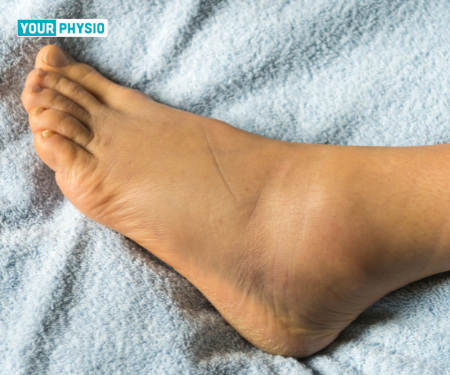Ankle Sprain PT (Physiotherapy)
Ankle sprains are the second most common injury in sports and recreational activities. It is also one of the most common injuries in the workplace. Physiotherapy can be an effective treatment for ankle sprains, but it depends on a few factors.
The goal of physiotherapy is to decrease pain, increase range of motion, and restore function to your ankle as quickly as possible. It will also address any underlying causes such as muscle imbalances or biomechanical problems that may have caused your injury.
There are many benefits from physiotherapy for a sprained ankle. One of these benefits is that it can help you get back to work sooner by restoring function and improving mobility before returning to full activity levels.
Henceforth, physiotherapy is an excellent way to recover from an ankle injury.
Does Physiotherapy Work For Sprained Ankle?
A sprain occurs when the ankle ligaments are stretched beyond their limits. An ankle sprain is actually an injury to the ankle ligaments, which are elastic band structures that hold the ankle bones together and prevent excessive rotation and twisting of the joint at the ankle joint.
If you have recently sprained or injured your ankle from sports or everyday activities, you should do strengthening exercises.
Once you have a sufficient range of motion and can comfortably walk with your injured ankle, it's time to move on to the next step.
Precisely, even if your ankles feel better, keep doing strengthening, balance, and control exercises a few times a week to keep your ankles strong.
Even if you don't need surgery, you will likely need to go through a rehabilitation and exercise program to treat your ankle injury. During a standard course of physiotherapy for ankle sprains, patients learn to regain balance and improve stability.
Four physiotherapy exercises to help you recover from an ankle sprain are the four-way ankle stretch, ankle alphabet (draw letters of the alphabet A to Z with your toes while sitting with your legs out in front of you), weightlifting, and balance exercises. They can start with "passive" movements your physiotherapist does to gently move your ankle and foot, and then progress to "active" exercises and stretches that you do yourself.
Exercise will be the most important part of ankle treatment and will help you succeed in the long run.
Start each exercise slowly and adjust its intensity based on your level of pain. When you're finally able to safely transfer all your weight to your ankle, your physiotherapist may prescribe exercises to get you back to normal activities.
A physiotherapist determines when you are ready to resume your activity and movement. They help ensure your ankle is strong and ready through body awareness and balance training, exercises to correct certain muscle imbalances and weaknesses, exercises to improve mobility, and help action.
A progressive functional training program allows you to gradually and safely return to activity without injury.
8 Ways Physiotherapy Can Help You Recover From Your Ankle Injury
Physiotherapy is a great way to help you recover from your injury and get back on your feet as quickly as possible.
It's important to rest and ice your ankle to help relieve the initial symptoms of a sprained ankle, and physiotherapy can play an important role in getting you back into motion. Fortunately, in many cases, physiotherapy can help reduce symptoms and restore function associated with a high ankle sprain. For high-grade 1 and 2 ankle sprains, conservative management of physiotherapy is often effective in reducing symptoms and restoring function.
The following are 8 ways physiotherapy can help you recover from your ankle injury:
1. Restore Range of Motion:
Restoring range of motion will help you get back on your feet and be able to walk without pain or discomfort. This can be done by using modalities like ultrasound or electric stimulation.
2. Strengthen Weak Muscles:
Ankles need strong muscles on all sides to support the joint. The muscles on the outside need to be strengthened so they can provide stability while walking or running.
3. Reduce pain:
Physiotherapists will use a variety of techniques to help reduce the pain in your ankle joint and foot such as
Ice Therapy:
Heat Therapy:
Dry Needling:
Massage therapy:
Ultrasound therapy:
4. Improve mobility and stability:
Physiotherapists help you in improving mobility by using exercises that will strengthen muscles around the ankle joint and feet while also improving balance and coordination.
5. Identify the severity of the injury:
Physiotherapists examine the condition according to their symptoms. For instance, a low ankle sprain causes minimal soreness and pain. On the contrary, a high ankle sprain can cause severe pain and seriously affect your ability to stand, walk, or exercise.
6. Improve proprioception (joint position sense):
Physiotherapists teach you strengthening exercises for these muscles to help you control your ankle and improve your sense of joint position. When you sprain your ankle, these receptors and our muscles cannot do their job well, which can lead to poor balance and difficulty performing normal activities such as walking.
7. Prevent future injuries:
A physiotherapist can help you learn movements and stretches that can help prevent future ankle injuries.
8. Reduce swelling:
Your physiotherapist may use a variety of treatments and techniques to manage and reduce pain and swelling. These include ice, heat, ultrasound, electrical stimulation, tape, special exercises, and hands-on treatments, such as soft tissue massage.
Some sprains may require physical therapy to relieve swelling and pain, such as ice or heat therapy, and electrical stimulation.
Conclusion: Is Physiotherapy the Answer For You?
Ankle sprains are a common injury that can be caused by many different things. The most common cause is tripping and falling on an uneven surface. Ankle injuries are also common in people who participate in sports like soccer, basketball, and volleyball. Try doing these exercises and then ice your ankle up to 5 times a day. This form of treatment strengthens the muscles around the ankle, improving balance and joint sensation.

Illustrations designed by freepik